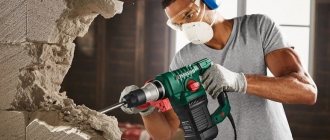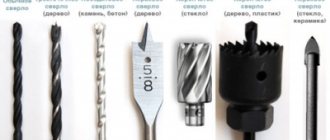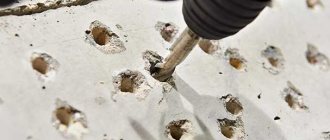Using a drill
Drills are suitable for creating new blind and through holes and increasing the diameter of existing ones. There are several types of drills:
- Twist drills - for wood, metal, stone. The most common type of drill. Their design feature is the presence of a corkscrew-shaped gutter. Twist drills are suitable for drilling holes on flat surfaces.
- Steel drill bits are an excellent option for wood and plastic. These are inexpensive products that are used for soft materials. In some cases, a steel drill bit can work with brick or metal, but wears out quickly. Accordingly, you can’t count on reusable use.
- HSS drills are slightly stiffer and can drill through harder materials faster and without dulling. They contain heat-resistant alloys that can withstand high temperatures.
- Titanium drills. Due to the titanium coating they have a golden color. Titanium is used for drilling hard materials. These drill bits will not be useful when working with wood or plastic.
- Masonry drills have a sealed corkscrew. The tip has the shape of an arrow. They are commonly used in hammer drills to grind down brickwork as they cut through it. These drills are best for making holes in stone foundations.
Drill and its features
Drills are used in cases where it is necessary to drill a hole larger than that provided by a standard drill. The following types of drills are distinguished:
- Spade drills for concrete: have a wide, flat shape. They are used to quickly drill large round holes in wood. When working with such tools, be sure to place wood under the workpiece. This way, you will prevent splitting;
- Annular: These, like spade drills, are used to create holes in wood, but can also process plastic and metal. Ring drills cut through wood, so you need to be careful when working;
- Forstner drills have a round, flat cutting edge surrounding a short central guide point. These drills can cut holes at an angle and even drill overlapping holes. Used for the most accurate holes;
- Grinding stone drills help grind, deburr and polish rough surfaces;
- Countersink drills look like arrows because of their fluted, cone-shaped tip.
How to work with a drill and drill: rules
To avoid accidents and breakdowns, it is important to follow a few simple rules when working with the tool. Let's look at a few main ones:
- Secure the drill blank with a crowbar. This will minimize chipping if the drill breaks. This clause does not apply to twist drills.
- The drill should make the hole gradually. Don't use force to try to do the job faster than the drill can. Most often, this leads to overheating and even burning of the instrument.
- Check that the head is securely attached. If possible, use a drill press and secure the part you are drilling to. When using a portable drill, clamp the workpiece and hold the drill with both hands.
- Before starting work, the drill is securely fixed in the drill chuck, or the drill in the hammer drill.
- When drilling, you should not leave your eyes unprotected; use special glasses.
- Remove chips from the hole while drilling. When working with metal, do not forget that its shavings are very sharp.
- Remember that after drilling into concrete, the drill bit will be hot. It is better not to try to pull it out of the tool right away, so as not to get burned.
- Use only sharp bits, augers and drills to prevent damage to the tool itself and to get the job done.
- When choosing drills for concrete, it is better to choose models made of high-speed steel.
A drill is a tool or consumable
Consumables in construction and repair, what are they?
A drill is a tool, or a consumable.
Consumables are materials that are consumed during repair and construction work, that is, not tools, but materials with a short service life.
These include various building mixtures (+ sand, cement, primers, putties, glue), as well as removable elements of power tools.
For example, cutting and grinding wheels for grinders (angle grinders), drills for rotary hammers, drill bits for electric drills, cutters, blades for various hacksaws, clorons, etc.
As well as cutting discs for saws (for example, circular saws), or files for an electric jigsaw.
Hardware is also consumables (self-tapping screws, nuts, bolts, screws, clamps, nails, various rivets, etc.).
Polyurethane foam, masking tape, sandpaper.
Drills (any kind, for metal, concrete, wood) are also consumables; in the process of performing work, they wear out and break.
From personal experience I can add that the cost of consumables is included in the cost of payment for the work performed.
That is, you need to immediately calculate how many circles you will need (this is for example) for an angle grinder, how many blades for a hacksaw for metal, or files for a jigsaw.
As a rule, all consumables are purchased by the person carrying out repairs or construction work, but the cost is paid by the customer.
Well, or the cost of consumables is immediately included in the estimate, not each individual consumable, but everything as a general line.
Read also: Physical wear and tear of home furnishings
Drills are used for impact drilling in concrete, brick and stone using a hammer drill. Drills vary in diameter, length and shank type. The length of the drill can be total - from tip to tip, and working - from the beginning of the spiral to the tip with a carbide plate.
Standard shanks – SDS-Plus and SDS-Max, SDS-Quick. The SDS-Plus and SDS-Max drill mounting system is used for rotary hammers and demolition hammers from BOSCH, AEG, DeWALT, Makita, HITACHI, Hilti, Ryobi, Kress, Skil, Milwaukee and others. There are less common and outdated systems:
- SDS-Top for old BOSCH rotary hammers;
- SDS square 9mm for Asian tools;
- HEX 13mm for Makita, HITACHI;
- HEX 19mm for Makita HK1800, HITACHI HK1810;
- HEX 21mm for Makita, HITACHI, Milwaukee, Kango;
- HEX 17mm for old rotary hammers Makita 8035NB, HR3510, HR3520, HR3850, HM0810, HM0810T, HITACHI;
- Spline (large spline shaft) for AEG, BOSCH, Atlas Copco, Milwaukee, Hilti, HITACHI, Kango, Makita, Metabo.
Each drill is designed for a specific type of drilling (light, medium and heavy) and is suitable for certain hammer drill models. If there is a discrepancy, the drill breaks. There are additional nuances: metal quality, soldering shape, fastening reliability, wear resistance and vibration level. According to extended criteria, drills are chosen by professionals for permanent and long-term work. At home, it is enough to have a set of drills of popular or required sizes of standard quality.
Types of drill spirals
Causes of drill failures - warranty cases
The carbide brazing and the drill body at the brazing point are broken. There are no traces of solder where the carbide brazing was located. The wear of the drill head is insignificant. The reason is a manufacturing defect, poor-quality soldering or a defect in the metal of the head part.
The carbide brazing is completely absent; no traces of brazing on the main part of the drill are visible. The reason is a manufacturing defect, poor-quality soldering.
Read also: Mathematical model of an axial piston pump regulator
The head of the drill is broken precisely under the carbide brazing, which seems to be cut at an angle of 90 degrees to the axis of the drill. The fracture surface is smooth. The reason is a manufacturing defect, a defect in the metal of the head part.
The drill is broken in the spiral area. The fracture surface is smooth, at an angle of 90 degrees to the longitudinal axis of the drill. The reason is a manufacturing defect, a metal defect.
Causes of drill failures – non-warranty cases
The carbide has been ground off or the edges have been rounded. There are significant signs of wear on the drill body. The reason is natural wear and tear.
The carbide solder is destroyed, part of the solder is still securely soldered to the main part of the drill. The drill head is partially rounded or damaged. The reason is getting into reinforcement or concrete.
The drill is broken in the spiral area. The shape of the fracture is uneven and is not located at an angle of 90 degrees to the drill axis. The reason is excessive bending or torsion load.
The drill spiral is clogged with foreign materials: fibers, paint, glue, etc. This causes poor sludge removal and overheating of the consumable. The drill may break and excessive wear on its body may occur. The reason is the use of the drill for other purposes.
Tips for using drills
When using long drills over 460mm, we recommend pre-drilling with a drill 210mm long.
Use special lubricants (gels or aerosols). They provide protection from moisture, have anti-corrosion and conservation properties, and therefore increase the service life of the hammer drill barrel.
Observe the drilling axis. The drill may break if it is skewed.
Select the nozzle specifically for the hammer drill, otherwise you will break the tool.
Basics of choosing pumping stations and five proven models
Because You are not logged in. To come in.
Because The topic is archived.
Childish question. ) Yes, the customer doesn’t give a damn what you include in the estimate - just include it in the price of a square meter, round meter or linear meter and that’s it.
Read also: What acid eats away rust?
and if you start him separately, he will say dearly. When you order, you will only receive money, everything else must be included in the price in any way - ask, show the calculation, otherwise you cannot guarantee quality.
But the dressing gowns and other work clothes are yours, because the contractor doesn’t care whether he’s wearing shorts, he is not responsible for labor safety, in terms of protecting the contractor’s personnel. Or he simply won’t let you in without a robe. ¶
Conclusion: what is the difference between a drill and a concrete drill?
A drill is used for drills, drills are used for hammer drills. When considering the two technologies, drilling and drilling, the first method is superior from a mechanical point of view. In the drilling process, the impact function is considered secondary. In hammer drills it comes to the fore. Chiseling is accompanied by high speed. Also, hammer drills and drills are designed for more durable materials, so they can solve problems that a drill cannot handle. This is their main difference.
Choosing the right drill
The very first thing I would like to start with is that to work with concrete you should use a hammer drill with drills - attachments of the required diameter, if, of course, you want to achieve the desired result.
But that’s not all, you can take a hammer drill of any power and still not achieve your goal. Only a well-chosen drill will be the key to the best result and accurate implementation of the assigned tasks.
The difference between a drill and a drill
At first glance, an ignorant person will have difficulty distinguishing a concrete drill from a drill with a Pobedit tip, used on the basis of an impact drill.
Not at all, there are differences that are quite significant:
- The drill shank has a complex shape according to the SDS standard, while the drill shank is smooth.
- The grooves on the drill, twisted in the shape of a spiral, are sharp and cutting, and in the drill, these same parts are designed to remove dust and concrete crumbs formed during the drilling process.
The photo shows exactly the drill that is used for the hammer drill
- Unlike their counterparts, hammer drill bits are not sharpened, cooled or hardened . They are usually disposable and cannot be corrected or repaired. In this regard, they are usually sold in packs of ten pieces.
Attention! The operating instructions for three-mode hammer drills allow you to use them in combination with a drill in drill mode, using a special adapter (included in the kit). Drills can also be installed on a drill, but don’t expect efficient operation from this combination. Moreover, the nozzle may get stuck in the chuck, and instead of drilling, you will have to repair the drill.
This is what a drill bit looks like, which can be used to make shallow holes











